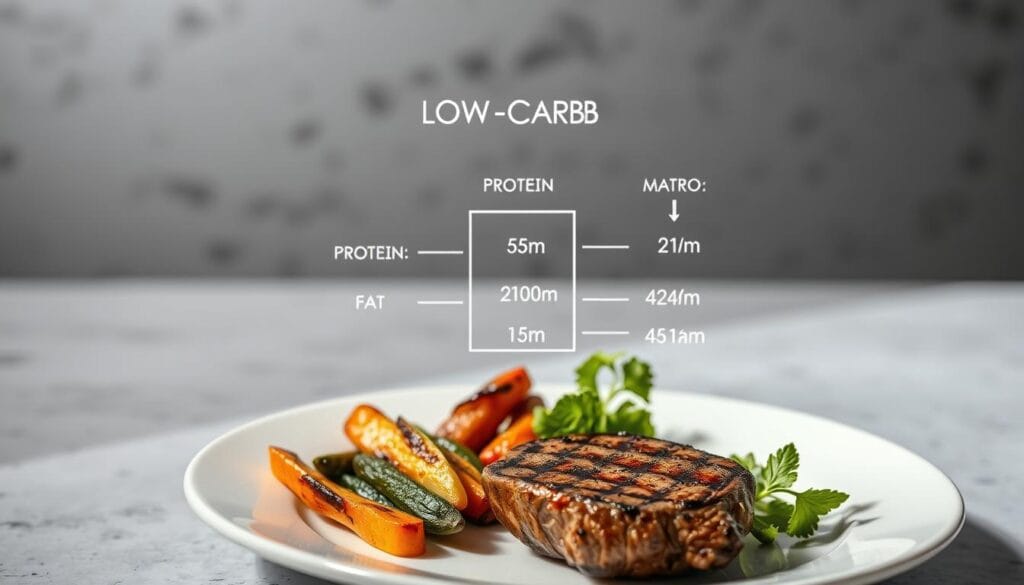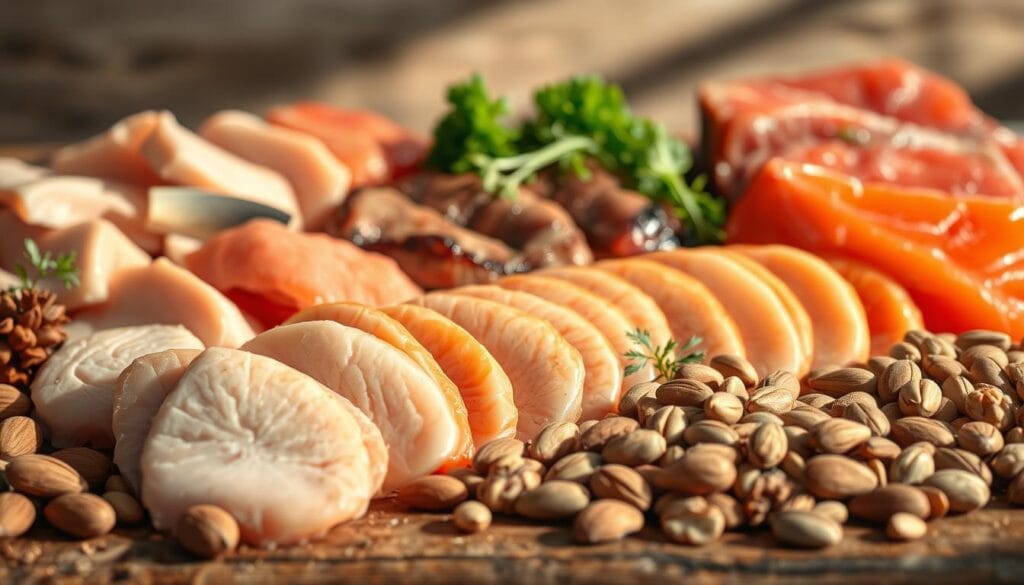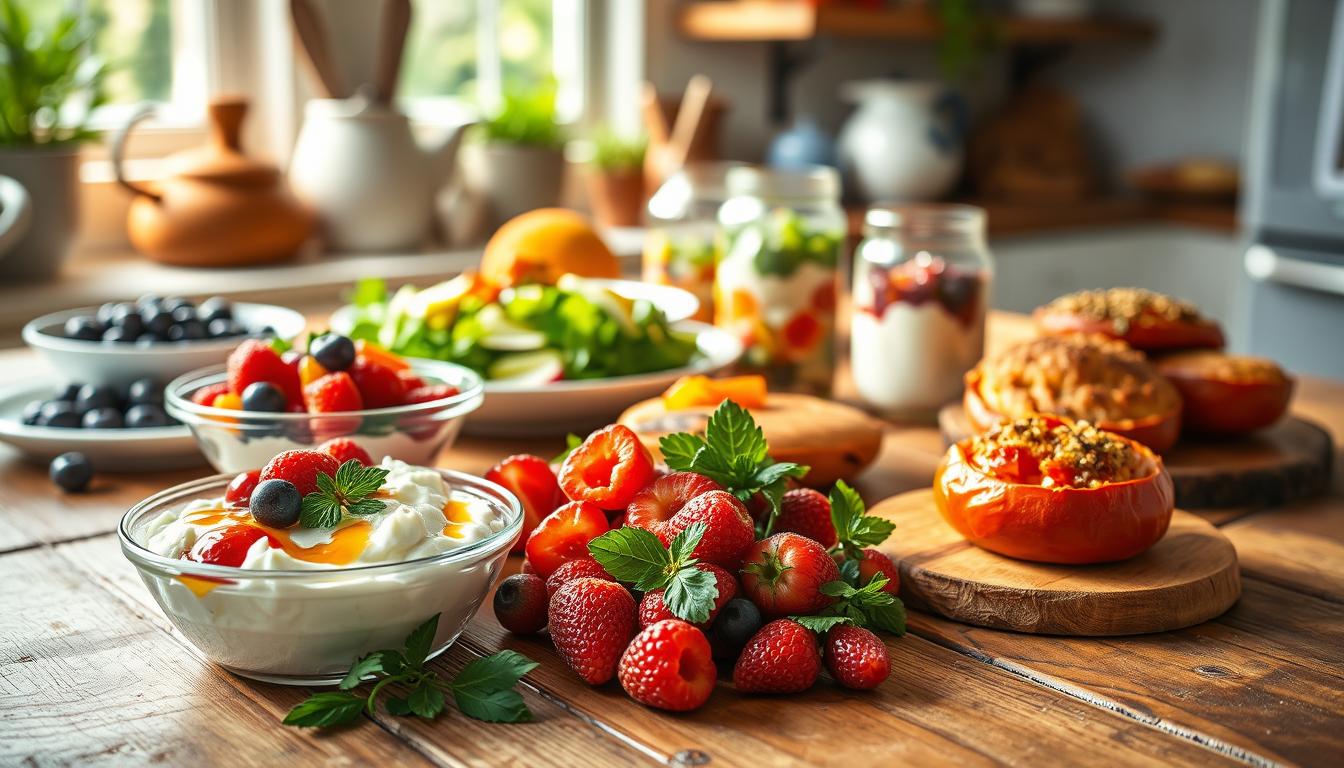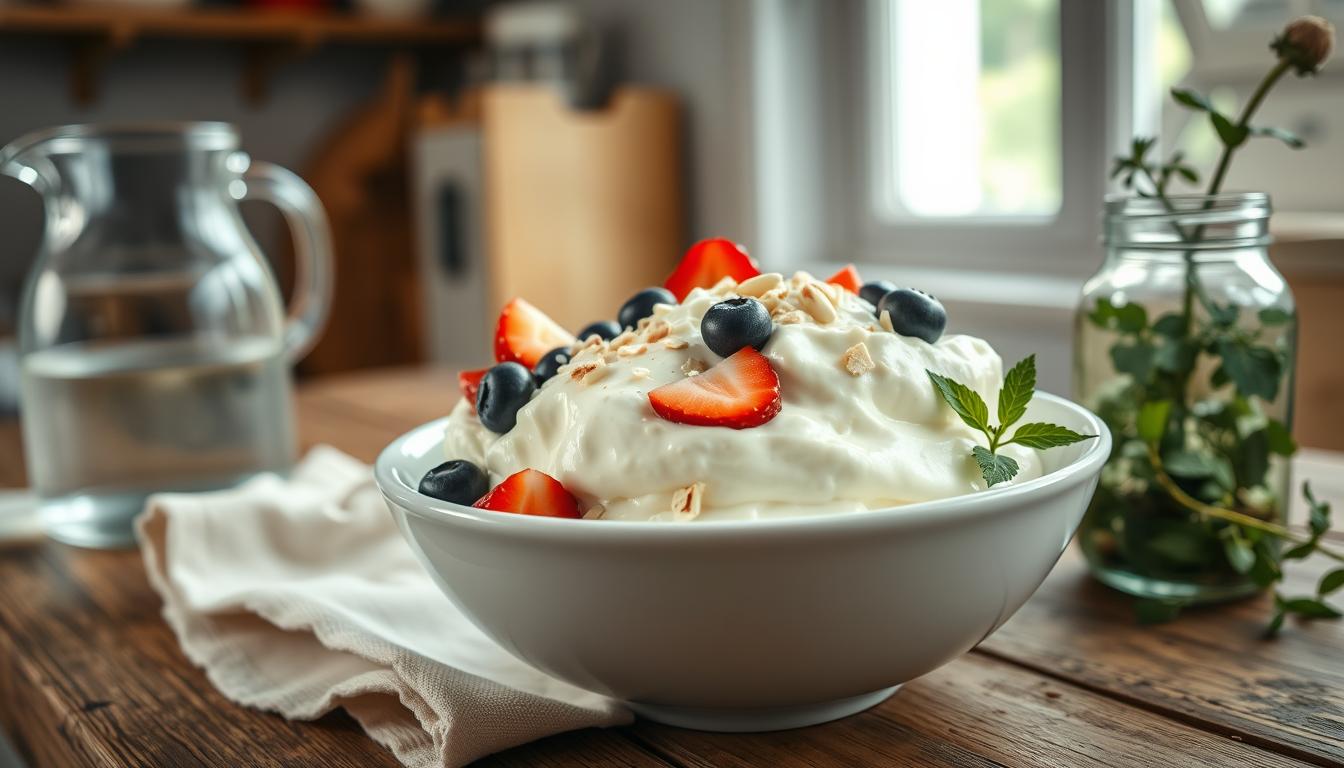Starting a low carb diet is all about the right grocery list. Knowing which foods to pick makes your diet exciting and easy to stick to. A good plan helps you shop with confidence, choosing foods that are good for your health.
Creating a good low carb diet grocery list is key. You want to eat 50 to 150 grams of carbs each day. Focus on high-quality proteins, veggies, and healthy fats. How you shop can really help you stay on track.
Choosing the right foods lets you make tasty meals that also meet your health goals. By picking whole, unprocessed foods, you’ll build a healthy pantry. This will keep you energized on your low carb journey.
Table of Contents
Understanding the Basics of Low Carb Eating

Looking into low carb diet tips can change how you see food and health. A low carb diet isn’t just a trend. It’s a smart way to eat that cuts down on carbs and focuses on protein and healthy fats.
What Defines a Low Carb Diet
A low carb diet means eating less than 26% of your daily calories as carbs. That’s about 130 grams of carbs on a 2,000-calorie diet. There are different types, like:
- Moderate low carb: 100-150 grams of carbs daily
- Ketogenic diet: Less than 50 grams of carbs per day
- Very low carb: Under 10% of total daily calories from carbohydrates
Benefits of Following a Low Carb Lifestyle
Using keto shopping list strategies can bring many health benefits. Studies show it can help with:
- Weight loss support
- Improved blood sugar control
- Potential cardiovascular health improvements
- Enhanced metabolic function
Daily Carb Intake Guidelines
| Diet Type | Daily Carb Intake | Calorie Percentage |
|---|---|---|
| Standard Dietary Guidelines | 45-65% of calories | 225-325 grams |
| Moderate Low Carb | 100-150 grams | 20-30% of calories |
| Ketogenic Diet | Less than 50 grams | 5-10% of calories |
Your carb needs vary based on age, activity level, and health goals. Getting advice from a nutritionist can help create a tailored low carb plan.
Essential Proteins for Your Low Carb Diet Grocery List

Protein is key in a low carb diet. It helps keep muscle mass, keeps you full, and supports your health goals. Choose high-quality proteins that are low in carbs for your meals.
Here are the top protein sources for your low carb diet:
- Eggs: A versatile protein powerhouse with just 0.6g of carbs per large egg
- Poultry: Chicken and turkey breast provide lean protein
- Fish: Wild-caught salmon and mackerel offer 21 grams of protein per serving
- Beef jerky: Options like Country Archer with 11g protein and only 2g carbs
- Seafood: Tuna packets with 14g protein and minimal carbs
For plant-based protein options in your low carb meal plan, consider:
- Edamame: 9g protein and 7g carbs per 1/2 cup
- Cottage cheese: 24g protein per cup
- Protein powders: Thrive Market Organic Whey with 20g protein
When shopping, choose proteins that are minimally processed. Opt for grass-fed meats, wild-caught fish, and organic options. This will help you get the most nutritional value.
Fresh Produce to Include in Your Cart
Exploring the produce section is key for a good low carb shopping guide. Your picks can turn healthy snacks and meals into tasty, low-carb options. Knowing which veggies and fruits are best helps build a balanced low-carb diet.
Non-Starchy Vegetables: Your Low Carb Allies
Non-starchy veggies are packed with nutrients for your low carb diet. They’re low in carbs but high in goodness. Make sure to add these to your shopping list:
- Leafy greens (spinach, kale, arugula)
- Cruciferous vegetables (broccoli, cauliflower, cabbage)
- Zucchini and summer squash
- Bell peppers
- Asparagus
- Mushrooms
Low Carb Fruits: Selecting Smart Choices
Not all fruits are good for a low carb diet. Choose fruits that are tasty and low in carbs:
- Berries (strawberries, raspberries, blackberries)
- Avocados
- Olives
- Small portions of melon
Fresh Herbs and Seasonings: Flavor Without Carbs
Boost your snacks and meals with fresh herbs and seasonings. They add flavor without carbs:
- Basil
- Cilantro
- Parsley
- Thyme
- Rosemary
- Garlic
- Fresh ginger
By picking the right produce, you’ll make tasty, healthy meals. These meals will support your low carb lifestyle and keep your taste buds happy.
Dairy and Alternatives for Low Carb Success
Finding the right dairy can be key for your low carb meal prep. Full-fat dairy is rich in nutrients and low in carbs. Knowing which dairy to choose is important for a successful low carb diet.
Look for dairy with high fat and low carbs. Cheese is a top choice, packed with nutrients and flavor. For example, an ounce of cheddar cheese has 1 gram of carbs, 6 grams of protein, and 9 grams of fat.
- Full-fat cheeses (cheddar, gouda, brie)
- Heavy cream
- Greek yogurt (full-fat, unsweetened)
- Butter
- Cottage cheese (full-fat)
If you can’t have dairy, there are good alternatives for low carb meal prep:
- Coconut milk
- Almond milk (unsweetened)
- Soy milk (in moderation)
| Dairy Product | Carbs (g) | Protein (g) | Fat (g) |
|---|---|---|---|
| Cheddar Cheese (1 oz) | 1 | 6 | 9 |
| Heavy Cream (1 tbsp) | 0.4 | 0.1 | 5 |
| Greek Yogurt (full-fat, 6 oz) | 6 | 15 | 8 |
Pro tip: Always check labels to avoid hidden carbs in dairy. Opt for full-fat, simple products to help you stay on track with your low carb diet.
Healthy Fats and Oils Selection
Healthy fats are key in a low carb diet, giving energy and vital nutrients. The right fats can make your keto shopping list much better.
It’s all about choosing the best fats for health. Your body needs certain fats to stay healthy on a low carb diet.
Essential Cooking Oils
- Extra virgin olive oil
- Coconut oil
- Avocado oil
- Macadamia nut oil
Natural Fat Sources
Add these fat-rich foods to your keto list:
- Avocados: Over 60% monounsaturated fat
- 161 calories per 100g
- 14.75g of fat
- Only 1.83g net carbs
- Grass-fed butter
- Full-fat dairy products
Nuts and Seeds
Nuts are great for your low carb diet. Here’s a quick look at their nutrition:
- Mixed nuts (1 ounce):
- 172 calories
- 15.3g fat
- 3.97g net carbs
- Recommended serving: ¼ cup, 3 times per week
A 2022 study showed that regular nut consumption is associated with lower mortality risk among adults.
When picking fats for your low carb diet, choose high-quality ones. Avoid processed fats and go for whole foods for the best nutrition.
Smart Pantry Staples for Low Carb Cooking
Having a well-stocked low carb pantry is key to making tasty low carb dishes. Your pantry should hold ingredients that help you follow your low carb diet. This makes cooking fun and easy.
Choose ingredients that are both nutritious and low in carbs. Here are some must-haves:
- Almond flour: A great low-carb flour substitute
- Coconut flour: Ideal for baking low carb goodies
- Sugar substitutes like erythritol and stevia
- Low-carb condiments and spices
- Unsweetened cocoa powder
- Nutritional yeast
Adding these smart items to your pantry will make cooking low carb easier:
- Chia seeds (about 5 grams of carbs per tablespoon)
- Flaxseeds (around 3 grams of carbs per tablespoon)
- Pork rinds (no carbs)
- Unsweetened almond milk (3.2 grams of carbs per cup)
Always check labels to avoid carbs you don’t want. Your pantry is your ally for a successful low carb life. It ensures you have what you need to make healthy, tasty meals.
Low Carb Diet Grocery List Must-Haves
Starting a low carb meal prep plan needs careful planning and the right tools. Your shopping list should help you set up an efficient kitchen. This setup supports your healthy eating goals.
Kitchen Essentials for Low Carb Cooking
Having the right tools in your kitchen makes low carb meal prep easier. Here are some must-haves:
- Sharp chef’s knife for precise vegetable cutting
- Quality cutting boards
- Digital food scale for accurate portion control
- Meal prep containers with compartments
- Spiralizer for vegetable noodles
- High-powered blender
Smart Storage Solutions
Keeping your low carb ingredients fresh is key. Invest in:
- Airtight glass containers
- Vacuum sealer
- Refrigerator organizers
- Mason jars for salad and sauce storage
Meal Prep Fundamentals
Make your low carb meal prep more efficient with these tips:
- Batch cook proteins on weekends
- Pre-chop vegetables
- Prepare grab-and-go snack packs
- Create weekly meal plans
Pro tip: Spending 2-3 hours on weekends on meal prep can save a lot of time during busy weekdays.
Convenient Low Carb Snack Options
Finding tasty healthy low carb snacks can change your diet game. When you’re hungry between meals, you need snacks that fill you up without ruining your diet. The best low carb foods give you quick energy and stop you from eating too much at main meals.
Here are some top snack choices that fit perfectly into a low-carb lifestyle:
- Nuts and Seeds: Almonds, macadamia nuts, and pumpkin seeds offer protein and healthy fats
- Cheese Options: String cheese, provolone, and cream cheese provide protein with minimal carbs
- Protein-Packed Choices: Hard-boiled eggs, turkey slices, and tuna are excellent low-carb alternatives
- Vegetable Snacks: Celery sticks, cucumber slices, and bell pepper wedges with dips
For those craving something crunchy, consider these quick snack ideas:
- Kale chips (approximately 3 grams of carbs per serving)
- Cheddar cheese crisps (0.6 grams of carbs per ounce)
- Homemade roasted pumpkin seeds
It’s important to control your portions when enjoying these snacks. Measure your servings to stay within your daily carb limits. Preparing snacks ahead of time helps you make better choices all day.
Pro tip: Always keep a variety of best low carb foods on hand to prevent impulsive eating and support your nutrition goals.
Foods to Avoid When Shopping
Shopping for a low carb diet can be tough. You need to watch out for ingredients that can mess up your diet. Knowing which foods to skip is key to a successful low carb diet.
- Sugary beverages and sodas
- Bread and bakery products
- Pasta and rice
- Starchy vegetables like potatoes
- Most processed snack foods
Make sure your cart doesn’t have foods that raise blood sugar and mess with your keto goals. Processed foods are especially bad.
| Food Category | Items to Avoid | Low Carb Alternatives |
|---|---|---|
| Grains | White bread, wheat flour | Almond flour, cauliflower alternatives |
| Fruits | Bananas, grapes | Berries in moderation |
| Snacks | Chips, crackers | Nuts, cheese crisps |
Reading labels is your best friend for a low carb life. Watch out for hidden sugars and carbs in seemingly healthy foods.
Pro tip: Shop the perimeter of the grocery store where fresh proteins, vegetables, and dairy are typically located.
Budget-Friendly Low Carb Shopping Tips
Creating a low carb diet grocery list doesn’t have to be expensive. Smart shopping can help you stay within your budget while eating healthy. The trick is to know how to buy wisely, getting great value without giving up on your diet goals.
Seasonal Shopping Strategies
Seasonal veggies are a great way to save money on low carb foods. They’re often cheaper because they don’t have to travel far. Check out farmers markets or local stores for affordable picks like zucchini, spinach, and cauliflower when they’re in season.
Bulk Buying Benefits
Buying in bulk can cut down your costs per serving. Stores like Aldi and Costco have great deals on low carb items like nuts, seeds, and frozen meats. Think about getting a chest freezer to save on meat and prep meals in advance.
Store Brand Alternatives
Generic or store-brand products are often just as good but cheaper. Look for them for canned fish, eggs, and frozen veggies. Online shopping can also help you find deals, saving up to 15% on your grocery list.


